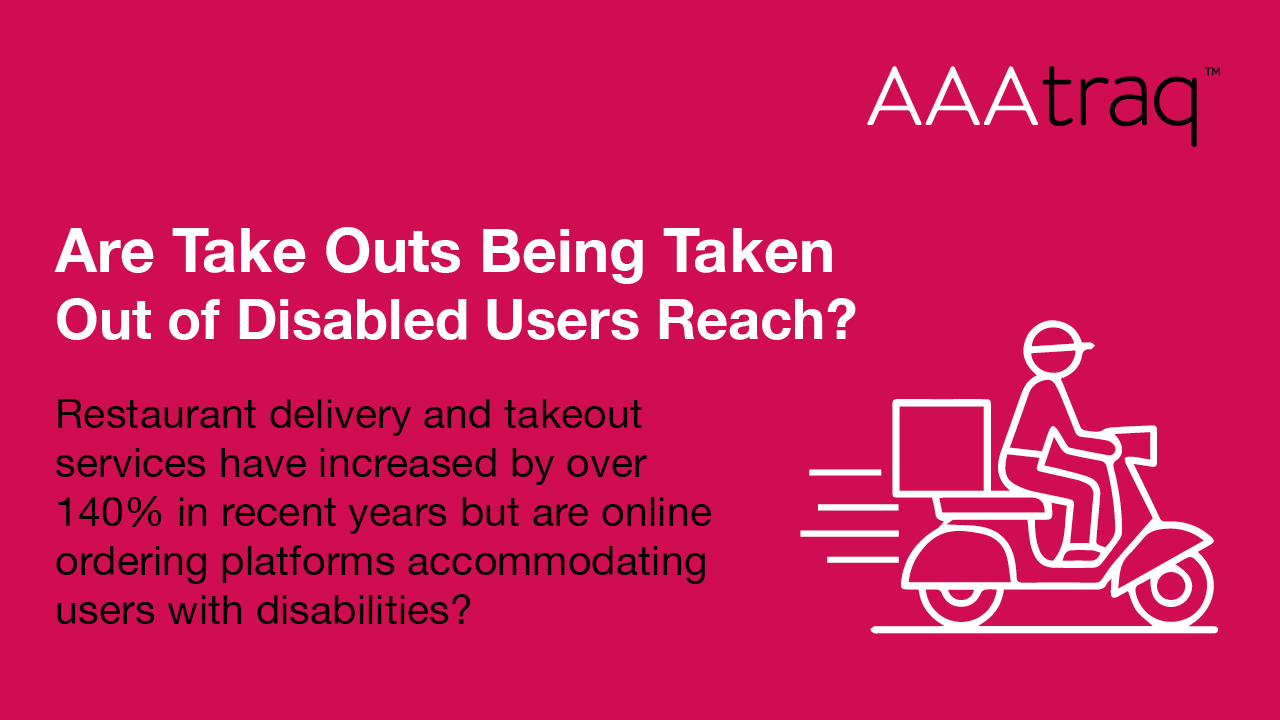Are Take Outs Being Taken Out of Disabled Users Reach?
Feb 03 2022
Today’s highspeed world demands that individuals seek out the most efficient and convenient avenues to obtain the goods and services that they use in their everyday lives.
For many, today’s world demands longer work hours, fewer social interactions, and an unrelenting condition of stress present in one’s life. After such long and stressful days, many people find themselves too tired to cook, clean, or do anything other than recuperate before starting it all over again. Such a phenomena explains the rise of delivery/takeout ordering from restaurants. Over the last 5 years, delivery and teleordering has risen by 143.7% to become an $56.915 billion industry.1 The rise in consumer preference to take more convenient opportunities in completing daily activities was only exacerbated by the regional lockdown/quarantine orders due to the COVID-19 pandemic. While, during these lockdowns, diners were barred from dining in their favorite restaurants, most municipalities allowed these restaurants to continue (or start) takeout and delivery services. As such, the online ordering market for restaurants boomed.
Online ordering platforms, including those not solely dedicated to food delivery, have long posed challenges to disabled users. Shoppers, or in the case of food delivery, diners, utilize the pages they visit to make decisions that have the potential to impact their lives. Every aspect of the page has the potential to have critical usability impacts on the disabled user. For a disabled user to have equitable access to the ordering platforms, aspects of the page such as alternative text to images of the items sold, proper link descriptions, and form field labeling must be designed in such a way that it is accessible to disabled users. What does this look like to websites?
How do you present your menu items?
One of the main barriers for visually impaired users when attempting to utilize online ordering software is the way in which the institution presents its menu. Many restaurants present their menus in one of two ways: the traditional textual menu whereby the restaurant presents the diner with the name of the dish, as well as a short description of that dish; another approach that has become more prominent by restaurant owners is by presenting their menu by visual (digital) representation of the dishes they are serving. Regardless of the way a menu is presented, it must be done in a way which is inclusive to the diners attempting to place an order. To such end, alternative text (also known as ‘alt text’) should be descriptive and be properly coded to allow screen reader software to describe the images of the items on the menu. Furthermore, most delivery services don’t just interface with prospective diners on a single page. Order placement, dish selection, payment, and confirmation all may occur on separate pages. Dishes may be more intricate than their descriptions, and there might be additional selections to be made on another page (such as a side dish, item temperature, or specialty requests). Such pages are connected to each other by links. To make these offerings accessible to disabled diners, the link text of such links should be unique and descriptive to enable screen reader users navigate the pages correctly.
How does the setup of your ordering platform affect usability?
The program layout has a significant impact on the usability of your platform. The number of pages a prospective diner interacts with, the ability for a screen reader to properly read the items and prices of menu items, and the availability of offers and deals to everyone in an accessible format significant impacts both the user and the restaurant. For the user, improper coding, labeling, and the disqualification from receiving the benefits available to an able-bodied user impacts their ability to order and pay for the services they which to employ. Such discrimination in use and ability to achieve equality in access to preferential rates and discounts based on disability status opens these entities (restaurants) to discrimination lawsuits under the Americans with Disabilities Act of 1990 (ADA). Depending on jurisdiction of said restaurant, they might find themselves in court and being subject to punitive damages.
What do you look for in choosing a vendor platform?
Restaurants often rely on vendors to supply platforms upon which diners can remotely place orders. While the restaurant may take steps to become compliant, their efforts may be for naught if they to direct prospective diners to use specific platforms or access certain content. It is therefore critical for the restaurant owners to ensure that every vendor it uses agrees to comply with the ADA and indemnifies the entity for its failures. Such contract clauses can protect the institution for the failures of the vendor.
1 “Online Food Delivery - United States: Statista Market Forecast,” Statista, 2021, https://www.statista.com/outlook/dmo/online-food-delivery/worldwide?currency=usd (opens in a new window)
Subscribe to AAAtraq and enjoy complete cover and peace of mind
